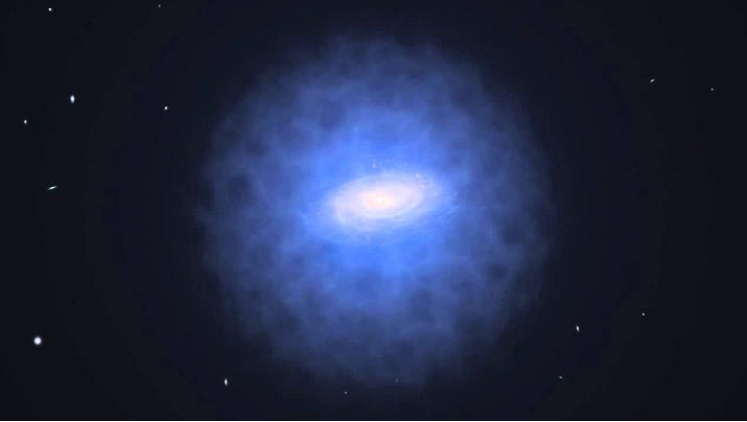Hypothetical 'dark photons' could shed light on mysterious dark matter
This massive particle could serve as the connection between dark matter and the everyday matter that comprises stars, planets and us.

A theorized massive particle called a "dark photon" could help shine a light on the secrets of dark matter, the universe’s most mysterious substance.
Dark matter is currently a huge problem for physicists because, despite comprising as much as 85% of the stuff in our universe, it remains effectively invisible. This is because dark matter doesn’t interact with light like the everyday matter that makes up stars, planets, and even our bodies, does. Dark matter can only be inferred through its interactions with gravity and its influence on everyday matter.
This strange lack of interplay with light, or electromagnetic radiation , also reveals dark matter isn’t made up of atoms that are composed of particles like protons and neutrons. That fact has spurred scientists to search for particles that could comprise dark matter; these particles would have to outnumber the particles which make up standard matter, also known as baryons, by a ratio of 5 to 1.
While dark photons aren’t usually suggested as a candidate for dark matter itself, they could be force carriers just like "ordinary" photons are. More specifically, these particles of light carry the electromagnetic force. And if they do carry some sort of dark electromagnetic force, per se, dark photons could act as a go-between for dark matter and ordinary baryonic matter. Potentially, that bridge would happen via an interaction known as "kinetic mixing" with standard photons.
Ultimately, understanding this interface could, in turn, help us understand dark matter.
Related: Astronomers weigh ancient galaxies’ dark matter haloes for 1st time
"The existence of dark matter has been firmly established from its gravitational interactions, yet its precise nature continues to elude us despite the best efforts of physicists around the world,"University of Adelaide Elder Professor of Physics Anthony Thomas said in a statement. "The existence of dark matter has been firmly established from its gravitational interactions, yet its precise nature continues to elude us despite the best efforts of physicists around the world."
Breaking space news, the latest updates on rocket launches, skywatching events and more!
Thomas was part of a team that looked at how dark photons could possibly affect collisions between particles at incredibly high energies by kinetically mixing with standard photons. Byproducts created by these collisions can give scientists a good picture of the universe at ultrasmall scales — smaller than that of the atom — as well as what physical laws are at play on these levels.
"In our latest study, we examine the potential effects that a dark photon could have on the complete set of experimental results from the deep inelastic scattering process," Thomas said.
Inelastic scattering results from billiard-ball-like collisions that happen when particles bump into one another and change the kinetic energy of the system. These inelastic collisions, first observed in 1922 in the form of X-rays scattered by a thin foil of graphite, can help scientists peer inside baryonic matter and the baryons themselves via the effect they have on other particles like electrons, muons, and neutrinos.
The team employed a state-of-the-art framework used to measure the distribution of these other particles to see how the particles that comprise protons and neutrons — quarks, antiquarks, and gluons — have momentum distributed among them after a collision. The framework is called the Jefferson Lab Angular Momentum (JAM) parton distribution function global analysis framework. However, the researchers modified the theory underlying this framework to allow for the existence of dark photons.
This analysis suggested the dark photon hypothesis was preferred over one that follows the Standard Model of Particle Physics, which neglects dark photons. And it did so, Thomas believes, to a significance that would be high enough in other circumstances to act as evidence for the discovery of a new particle.
Though the work doesn’t actually prove the existence of the dark photon, it surely narrows down the parameters at which this particle could exist, and builds toward an understanding of how strongly it would kinetically interact with standard photons. For future research into the existence of dark photons, the team suggests improving statistical analyses of all observables in the system being examined.
The team’s work was published on Sept. 15 in the Journal of High Energy Physics.

Robert Lea is a science journalist in the U.K. whose articles have been published in Physics World, New Scientist, Astronomy Magazine, All About Space, Newsweek and ZME Science. He also writes about science communication for Elsevier and the European Journal of Physics. Rob holds a bachelor of science degree in physics and astronomy from the U.K.’s Open University. Follow him on Twitter @sciencef1rst.

